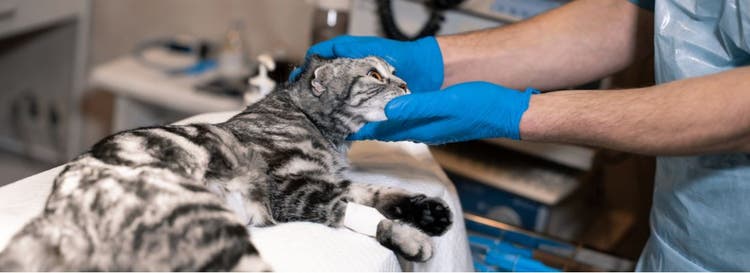
What is Cryosurgery for Your Pet?
Cryosurgery, sometimes referred to as cryotherapy or cryoablation, uses extreme cold to destroy abnormal or unwanted tissue. Utilizing liquid nitrogen, this process removes benign superficial growths on the skin, treats masses or abnormal eyelashes on the eyelids, removes papillomas (viral warts), and occasionally treats neoplastic conditions like cutaneous hemangiomas or squamous cell carcinomas.
The goal of cryosurgery is to employ intense cold to freeze and subsequently kill the targeted tissue, resulting in resolution of disease or abnormality. Since the removal of the tissue relies on the death of tissue, it may take 2-6 weeks to see results following the freezing procedure. Most small masses will only require one treatment, while larger masses may require follow up treatment to freeze any remaining tissue.
Benefits of Cryosurgery
- Cryosurgery can be performed with local anesthesia instead of general anesthesia.
- There are no stitches following the procedure.
- It provides a positive cosmetic outcome.
- It’s relatively painless.
One of the main drawbacks of cryosurgery is that tissue is not available for histopathology following treatment, so it is important to know specifically what type of mass your pet has before proceeding with cryosurgery. Your veterinarian may do a fine needle aspirate to evaluate cells from the mass to determine if the mass is appropriate for cryosurgical removal.
The most commonly-treated growths with cryosurgery include:
- Sebaceous (adenomas or hyperplasia). Most commonly seen in middle-aged or older animals. These are hairless waxy nodules that are occasionally called “old dog warts.”
- Papillomas. True viral warts caused by papilloma viruses on the skin or in the oral cavity are very susceptible to freezing.
- Hemangiomas. Small, blood filled nodules which are usually secondary to solar damage of the skin can be frozen.
Dermal or subcutaneous nodules cannot effectively be treated with cryosurgery. Treatment of certain tumors with cryotherapy, such as mast cell tumors, is contraindicated. Other less commonly treated diseases are based on the secondary effects of freezing. Freezing decreases nerve sensation, giving a numbing effect that decreases the desire to lick in acral lick granulomas. There is also thought to be some immune-modulating effects from cell death in treatment of viral disease and some neoplastic diseases.
The availability and training for cryosurgery varies. Some general practitioners may refer you and your pet to a veterinary dermatologist or ophthalmologist for treatment. Although cryosurgery is a suitable option for the treatment of a variety of masses, your veterinarian can best advise you based on evaluation of each concerning mass.